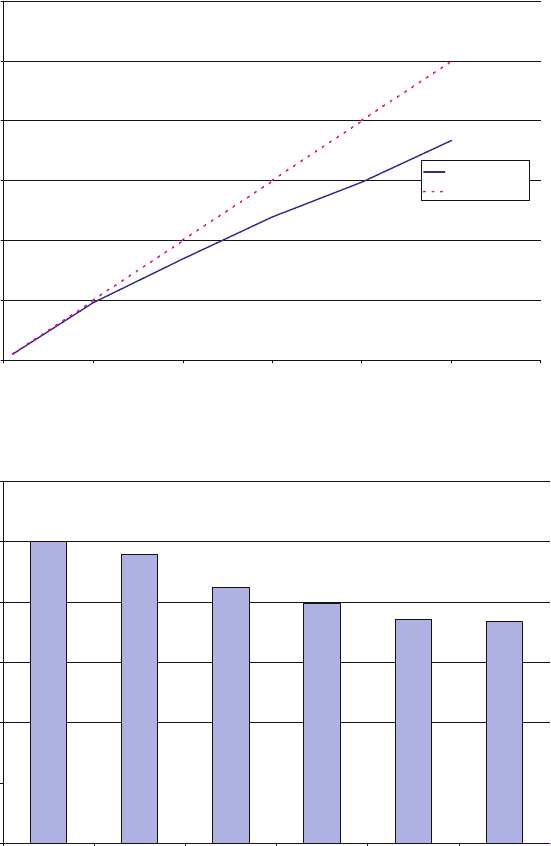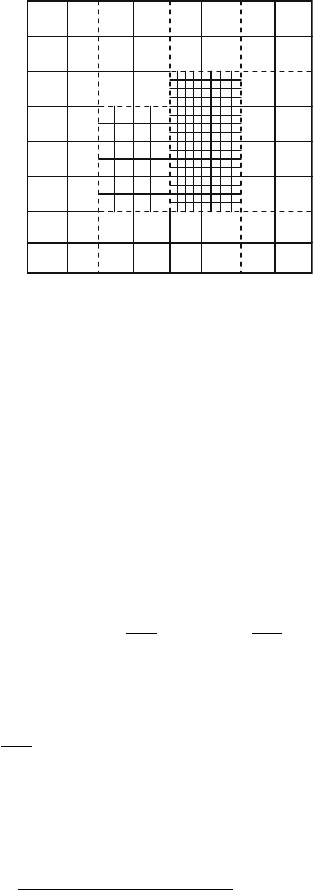Graziani F. (editor) Computational Methods in Transport
Подождите немного. Документ загружается.


Different Algorithms of 2D Transport 491
Computation
Ideal
0102030405060
N
Sp
0
10
20
30
40
50
60
Fig. 3. Speedup dependence on the number of processors
100
95.7
84.7
79.6
74.3
73.4
11020304050
N
En
0
20
40
60
80
100
120
Fig. 4. Dependence of the parallelization efficiency on the number of processors

492 R.M. Shagaliev et al.
Table 3. Speedup and parallelization efficiency in the second computation series
Number of Processors Speedup Parallelization
Efficiency
1 1 100
10 9.6 95.7
20 16.9 84.7
30 23.9 79.6
40 29.7 74.3
50 36.7 73.4
algorithm (combined) combines both the parallelization by space and en-
ergy variables.
When a multi-group transport equation is being sold, the computations of
the intervals or groups of intervals by the energy variable can be carried out
independently, each on a separate processor or a group of processors. Further
on, such groups of interval are called “group-domains”. Such an approach
allows to use a considerable number of processors at solving a 2D kinetic
equation, reasonable efficiency kept.
Numerical investigations of the combined parallelization algorithm effi-
ciency were carried out at three model problems. The method of problem
splitting was applied for computing the speedup and the parallelization ef-
ficiency. For this method the main parameters of the parallelization were
calculated using the following formulae:
The speedup:
Sp
n
=
t
1
t
n
,
where
t
n
is the average time of the problem computing at one processor when N
processors are run;
t
1
is the time of the problem computing at one processor;
The parallelization efficiency:
E
n
=
t
1
n
∗
t
n
∗ 100 .
For the first computation series one hemi-spherical space-domain model
problem had been selected as a test one: 80 rows were homogenously distrib-
uted at the radius, 200 columns were homogenously distributed at the angle.
The order of the angle quadrature was 12, in total there were 96 directions
of the particles motion. Number of energy groups was 28.
The result speedup and the parallelization efficiency are presented in Ta-
ble 4. The total number of processors, as well as the number of para-domains

Different Algorithms of 2D Transport 493
Table 4. Speedup (Sp) and the parallelization (E) efficiency in the first test com-
putation series
Number of Number of Group- Number of Para-
Processors Domains Domains Sp E,%
1 1 1 1 100
4413.589
7715.578
10 1 10 11.6 116
14 14 1 8.8 63
25 1 25 25.4 102
28 28 1 12.3 44
40 4 10 39.5 99
50 1 50 43.9 88
at parallelization by space and the number of group-domains at paralleliza-
tion by groups, are shown for each run.
The two-space-domain model problem for the second computation se-
ries was obtained from the previous problem by means of splitting into rows.
Two space-domains. In each space-domain the number of rows was 40,
homogenous by the radius, the number of columns was 200 homogenous by
the angle. The number of energy groups and other parameters of the problem
coincide with those of the one-space-domain problem. The incoming flow on
the outer edge of the first space-domain, corresponding to the temperature
1, was taken as the boundary condition.
The speedup and the parallelization efficiency, obtained in the course of
numerical research for different numbers of para-domains and group-domains,
are presented in Table 5.
Table 5. The speedup (Sp) and the parallelization efficiency (E) in the second test
computation series
Number of Number of Group- Number of Para-
Processors Domains Domains Sp E, %
1 1 1 1 100
10 1 10 9.4 94
25 1 25 20.7 83
40 4 10 31.1 78
50 1 50 36.6 73

494 R.M. Shagaliev et al.
The three-space-domain model problem for the third computation se-
ries was obtained from the previous two-space-domain problem by means of
splitting the first space-domain into columns.
Three space-domains. In the first and the second ones the number of
rows was 40, homogenous by the radius, the number of columns was 100,
homogenous by the angle. In the third space-domain the number of rows
was 40, homogenous by the radius, and the number of columns was 200,
homogenous by the angle. The number of energy groups and other parameters
coincide with those of the one-space-domain problem. The incoming flow on
the outer edges of the first and the second space-domains, corresponding the
temperature 1, was taken as the boundary condition.
The speedup and the parallelization efficiency, obtained in the course of
numerical research for different numbers of para-domains and group-domains,
are presented in Table 6.
Table 6. The speedup (Sp) and the parallelization efficiency (E) in the third test
computation series
Number of Number of Group- Number of Para-
Processors Domains Domains Sp E, %
1 1 1 1 100
10 1 10 7.5 75
25 1 25 20.3 81
40 4 10 24.9 62
50 1 50 34.9 70
Nowadays the most perfect parallelization algorithm is the one where
the matrix decomposition of the initial system is used. Unlike splitting the
system only into columns, here the space-domain was cut both into columns
and rows.
The main principles of the algorithm of minor block parallelization were
as follows:
• Application of spatial decomposition of the space-domain into para- do-
mains, the space-domain was split into columns and rows;
• The system of grid equations was solved independently by the angle vari-
able;
• Each para-domain of the current direction was solved with inner boundary
conditions, computed at the current iteration, which allows to keep the
solution precision and does not increase the total number of iterations
comparing with the step-by-step method;
• Complete integration of inter-processor data exchange with the computa-
tion, achieved by the application of asynchronous receive/send operations.

Different Algorithms of 2D Transport 495
A one-space-domain spherically symmetrical transport problem in the
one-group iteration was used as a test problem for the investigations of the
efficiency of the matrix decomposition method for solving 2D transport equa-
tions. The spatial grid comprised 1200 rows and 1200 columns. The problem
was computed on the angular grid with 6, 8, 12 and 14 intervals by µ for
the analysis of the influence of the interval numbers on the parallelization
efficiency. There were 5 computation steps with 6 iterations in each one. The
number of processors was selected so that the computation was balanced,
that is the number of calculated points was equal on each processor at a
time. The speedup and the parallelization efficiency are presented in Tables
7–10.
Table 7. Parallelization efficiency at µ =6
Np Time Sp En, %
1 3381.12 1.00 100.00
50 118 29 57.01
Table 8. Parallelization efficiency at µ =8
Np Time Sp En, %
1 5402.21 1.00 100.00
50 160 34 67.05
Table 9. Parallelization efficiency at µ =12
Np Time Sp En, %
1 10717.53 1.00 100.00
50 274 39 78.23
Table 10. Parallelization efficiency at µ =14
Np Time Sp En, %
1 13882.33 1.00 100.00
50 350 40 79.28
496 R.M. Shagaliev et al.
The following conclusion can be drawn out basing on the presented ma-
terial:
• Application of the combined parallel algorithm, that is the combination of
matrix geometrical and energy decomposition, is the most efficient one for
solving the 2D multi-group transport equations, as extra possibilities for
balancing the computation load on processors occur.
Part V
Neutron Transport
Parallel Deterministic Neutron Transport
with AMR
C.J. Clouse
Lawrence Livermore National Laboratory, Livermore CA
clouse1@llnl.gov
AMTRAN, a one, two and three dimensional Sn neutron transport code
with adaptive mesh refinement (AMR) has been parallelized with MPI over
spatial domains and energy groups and with threads over angles. Block refined
AMR is used with linear finite element representations for the fluxes, which
are node centered. AMR requirements are determined by minimum mean
free path calculations throughout the problem and can provide an order of
magnitude or more reduction in zoning requirements for the same level of
accuracy, compared to a uniformly zoned problem.
1 Introduction
AMTRAN, a two and three dimensional Sn neutron transport code designed
to run effectively on large parallel machines that have both distributed mem-
ory and shared memory parallelism, first began development in 1995 under
an industrial partnership agreement with several oil well logging companies
and LLNL. Due to shortened time lines and dwindling DOE funding in sup-
port of industrial partnership agreements, AMTRAN never became a major
contributor in oil well logging calculations. However, it was recognized as
an excellent R&D test bed for trying out new parallel algorithms and AMR
techniques as applied to the Boltzmann equation. Development has continued
over the years and, although the code and its algorithms have been presented
at several conferences [1, 2] this is the first publication of the basic code and
it’s techniques. At the time development began in 1995, the notion of apply-
ing AMR techniques to neutron transport problems was unexplored. Since
that time, a number of other AMR neutron transport codes have been devel-
oped [3,4]. AMTRAN, however, remains unique in its combination of degrees
of parallelism (MPI in space and energy and threading in angle) and its use
of finite element node centered fluxes (the other referenced AMR codes use
face or zone centered fluxes). As in the case of hydrodynamics, where spatial
AMR was first developed, many transport applications have widely varying
resolution needs within the same application. Stability and accuracy consid-
erations require that spatial zoning be able to resolve length scales less than a
neutron mean-free-path for most commonly used algorithms. This can be on
the order of a millimeter in fissionable materials of nominal density to a meter
500 C.J. Clouse
or more in air. An example of particular interest in our work is the interro-
gation of cargo containers for fissionable material using a 14 MeV neutron
source. The cargo container could be a semi-tractor trailer with the neutron
source situated on one side of the trailer and a detector located on the op-
posite side. The goal is to be able to match the detector signal with known
configurations of various types of fissionable materials. In this example, the
distance between source and detector could be many meters; the material
throughout most of which is probably air or some other material that is rela-
tively transparent to neutrons, but the fissionable target would require good
spatial resolution. Spatial AMR allows us to get the needed resolution in the
target without making the overall calculation unwieldy.
2CodeOverview
AMTRAN operates in 2D cylindrical and 3D cartesian geometries. Node cen-
tered fluxes are represented with continuous linear finite elements, similar to
the methods employed by Greenbaum and Ferguson [5]. Angular discretiza-
tion in 2D and 3D is with standard discrete ordinates and, therefore, requires
half angle approximations to maintain acceptable conditions on the ordinates
when finite differencing the angular derivative in cylindrical coordinates (see
[6] for a discussion of this topic). In 1D, a quadratic finite element approxima-
tion for the angular unknown has been implemented and provides significant
computational savings over standard differencing (see [7] for a detailed dis-
cussion). AMTRAN has several simple internal generators: nested spheres
with point to point linearly interpolated densities, nested cylinders with con-
stant densities and constant density cartesian blocks. It is also capable of
reading COG [9] input and using the geometry generator routines in COG
to construct a mesh.
2.1 Production of AMR Blocks
The AMR algorithm in AMTRAN is block based and thus produces a hexahe-
dral (quadrilaterals in 2D) block decomposition of the problem domain. Like
previous AMR work in the field of hydrodynamics, e.g. Berger and Colella
[8], the zone size in each direction is halved for each increase in level of refine-
ment, unlike most hydrodynamic AMR techniques, though, no level nesting
is required, i.e. it is possible to have adjacent blocks differ by any power of 2
in zoning, as illustrated in Fig. 1. Uniform zoning within a block allows fast
and efficient computation of the transport equation.
The refinement criteria is based on neutron mean free path considerations,
h<min
g
a
g
λ
g
(1)

Parallel Deterministic Neutron Transport with AMR 501
Fig. 1. 2D example where dashed lines indicate block boundaries
where λ
g
is the minimum neutron mean free path by energy group, h is the
zonal width and a
g
is a user defined multiplier, which can vary with energy
group. Blocks are created by beginning at the finest level and tagging all
zones that need to remain at that level. The tagged zones are boxed up using
a “smart bisection” algorithm that can be briefly described as follows for 3D
with the obvious extension to 2D.
Count up all the tagged zones in each 2D plane of the problem. Let y
i
represent the number of tagged zones in plane i, then define f
i
to be the
discrete function f
i
= y
i
.
The splitting plan, i = isplit, is chosen such that
isplit =max
d
2
dx
2
f(x
i+1
) −
d
2
dx
2
f(x
i
)
(2)
where the second derivatives are defined using a standard central difference
formula,
d
2
dx
2
f(x
i
) ≡ f (x
i+1
) − 2f(x
i
)+f(x
i−1
)(3)
A block is subject to further splitting until it satisfies one of two condi-
tions: 1) it no longer contains any tagged zones, in which case it is discarded,
or 2) it satisfies the following condition,
number of tagged zones
total number of zones
≥ irattag
where irattag is a user specified efficiency ratio. Generally, more and smaller
blocks will be produced as the value of irattag is increased.
2.2 Sweeping the Mesh
The time-dependent transport equation can be written as follows,
